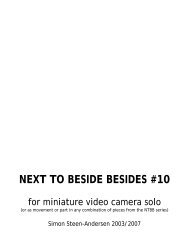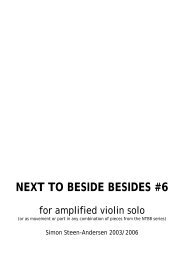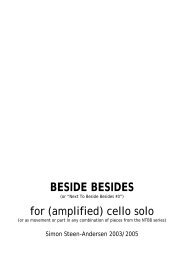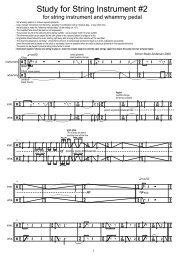In spite of, and maybe even therefore - Simon Steen-Andersen
In spite of, and maybe even therefore - Simon Steen-Andersen
In spite of, and maybe even therefore - Simon Steen-Andersen
- No tags were found...
You also want an ePaper? Increase the reach of your titles
YUMPU automatically turns print PDFs into web optimized ePapers that Google loves.
Flute:The flute is slowly taken apart: The flute is only played normally in thevery beginning. Mostly the flute part consists <strong>of</strong> taking the instrumentapart, playing on the bits <strong>and</strong> sliding them around on the table.Dynamics: The flute only has one dynamic in the piece; ppppp – as s<strong>of</strong>tas possible, but always sounding, <strong>and</strong> always trying to match thedifferent sounds dynamically. All actions are amplified.Resulting system: Above the main system is a small system with areduced <strong>and</strong> quantized result <strong>of</strong> the actions to show the wanted soundor pitch. A normal note head means pitch, a squared note head meansnoise, a cross means percussive sound.Tuning: The pitches in the resulting system are quantized pitches.Many <strong>of</strong> the alternative playing techniques produce tones, that are moreor less out <strong>of</strong> tune or very noisy. The harmonies (Bethoven Bagatellenop. 126) are not intended to be in perfect tune, but nevertheless, aneffort should be made to get as close to the written pitches as possible.Quasi legato / tenuto possible: All actions marked with a tenuto sign(-) are to be held <strong>even</strong>ly during their whole value, actively trying to makea quasi legato to the next action <strong>of</strong> the other instruments.Score: the part should be placed on the table, avoiding a st<strong>and</strong> to makethe actions as visible for the audience as possible.M*21: repeat measure 21 times.Detach / pick up – put on table.Noise sound – for example from sliding <strong>of</strong>f a part <strong>of</strong> the instrument.Blow into the instrument (as indicated) 1 cm. away from the hole.Slide object on table.Tap opening <strong>of</strong> the instrument with 1 finger / tap with the palm.Close tube – open tube.Blow into the key holes as close as possible – as if playing pan flute.Tremolo: Always as fast / dense as possible.Horn:Mute: The beginning <strong>of</strong> the piece is played with a yahama silents brasspractice mute.The horn is slowly taken apart: The horn is only played normally inthe very beginning. Mostly the horn part consists <strong>of</strong> taking theinstrument apart, playing on the bits <strong>and</strong> sliding them around.Dynamics: The horn only has one dynamic in the piece; ppppp –ass<strong>of</strong>t as possible, but always sounding, <strong>and</strong> always trying to match thedifferent sounds dynamically. All actions are amplified.Resulting system: Above the main system is a small system with areduced <strong>and</strong> quantized result <strong>of</strong> the actions to show the wanted soundor pitch. A normal note head means pitch, a squared note head meansnoise, a cross means percussive sound.Tuning: The pitches in the resulting system are quantized pitches.Many <strong>of</strong> the alternative playing techniques produce tones, that are moreor less out <strong>of</strong> tune or very noisy. The harmonies (Bethoven Bagatellenop. 126) are not intended to be in perfect tune, but nevertheless, aneffort should be made to get as close to the written pitches as possible.Quasi legato / tenuto possible: All actions marked with a tenuto sign(-) are to be held <strong>even</strong>ly during their whole value, actively trying to makea quasi legato to the next action <strong>of</strong> the other instruments.Score: the part should be placed on the table, avoiding a st<strong>and</strong> to makethe actions as visible for the audience as possible.Tubes: The tubes (<strong>and</strong> the corresponding keys) are numbered by size<strong>and</strong> horn (1 being the smallest); F-1, F-2, F-3 (middle pos., upper,lower), Bb-1, Bb-2, Bb-3. F-0 <strong>and</strong> Bb-0 are the tubes, leading the air tothe vaults.M*21: repeat measure 21 times.Detach / pick up – put on table.Noise sound – for example from sliding <strong>of</strong>f a part <strong>of</strong> the instrument.Blow into the instrument (as indicated) 1 cm. away from the hole.Slide object on table.Close tube – open tube.“Air guiro”: During the piece tubes are sled to the “front position”, justin front <strong>of</strong> the player. Blow on the setup <strong>of</strong> pipes one after the other,from one side to the other, very close to the pipes.






